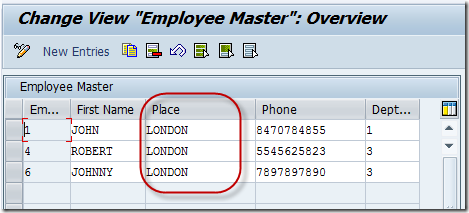Usually a SAP Table Maintenance View (SM30) with single screen displays all the records in the table as shown below.
What if we want to display only some records in SAP Table Maintenance View (SM30) based on the user selection? Just follow the below steps.
Create a report program and design the selection screen for the table/view as per your requirement.
Use the SAP function module VIEW_RANGETAB_TO_SELLIST to build the selection criteria for Table Maintenance View
Use the SAP function module VIEW_MAINTENANCE_CALL to call the Table Maintenance View (SM30)
TABLES: zemployee.
CONSTANTS: c_view TYPE char30 VALUE 'ZEMPLOYEE',
c_u TYPE char1 VALUE 'U',
c_and TYPE char3 VALUE 'AND'.
DATA: gt_seltab TYPE STANDARD TABLE OF vimsellist.
DATA: g_fieldname TYPE vimsellist-viewfield.
DATA: gt_exclude TYPE TABLE OF vimexclfun,
gwa_exclude TYPE vimexclfun.
SELECT-OPTIONS: s_id FOR zemployee-id,
s_name FOR zemployee-name,
s_place FOR zemployee-place.
*Add ID column to selection criteria of Table maintenanace view
g_fieldname = 'ID'.
CALL FUNCTION 'VIEW_RANGETAB_TO_SELLIST'
EXPORTING
fieldname = g_fieldname
append_conjunction = c_and
TABLES
sellist = gt_seltab
rangetab = s_id.
*Add Name column to selection criteria of Table maintenanace view
g_fieldname = 'NAME'.
CALL FUNCTION 'VIEW_RANGETAB_TO_SELLIST'
EXPORTING
fieldname = g_fieldname
append_conjunction = c_and
TABLES
sellist = gt_seltab
rangetab = s_name.
*Add Place column to selection criteria of Table maintenanace view
g_fieldname = 'PLACE'.
CALL FUNCTION 'VIEW_RANGETAB_TO_SELLIST'
EXPORTING
fieldname = g_fieldname
append_conjunction = c_and
TABLES
sellist = gt_seltab
rangetab = s_place.
* Call to the 'VIEW_MAINTENANCE_CALL' function module
CALL FUNCTION 'VIEW_MAINTENANCE_CALL'
EXPORTING
action = c_u
view_name = c_view
TABLES
dba_sellist = gt_seltab.
Selection Screen : Display all the entries in SM30 where place is LONDON
Table Maintenance View (SM30)
Use the ACTION parameter in FM VIEW_MAINTENANCE_CALL to call the Table Maintenance in Change or Display mode.
GUI function codes (Buttons) in the Table Maintenance can be deactivated using the Table parameter EXCL_CUA_FUNCT of FM VIEW_MAINTENANCE_CALL.
Below program deactivate New Entries, Copy and Delete buttons in SM30.
TABLES: zemployee.
CONSTANTS: c_view TYPE char30 VALUE 'ZEMPLOYEE',
c_u TYPE char1 VALUE 'U',
c_and TYPE char3 VALUE 'AND'.
DATA: gt_seltab TYPE STANDARD TABLE OF vimsellist.
DATA: g_fieldname TYPE vimsellist-viewfield.
DATA: gt_exclude TYPE TABLE OF vimexclfun,
gwa_exclude TYPE vimexclfun.
SELECT-OPTIONS: s_id FOR zemployee-id,
s_name FOR zemployee-name,
s_place FOR zemployee-place.
*Add ID column to selection criteria of Table maintenanace view
g_fieldname = 'ID'.
CALL FUNCTION 'VIEW_RANGETAB_TO_SELLIST'
EXPORTING
fieldname = g_fieldname
append_conjunction = c_and
TABLES
sellist = gt_seltab
rangetab = s_id.
*Add Name column to selection criteria of Table maintenanace view
g_fieldname = 'NAME'.
CALL FUNCTION 'VIEW_RANGETAB_TO_SELLIST'
EXPORTING
fieldname = g_fieldname
append_conjunction = c_and
TABLES
sellist = gt_seltab
rangetab = s_name.
*Add Place column to selection criteria of Table maintenanace view
g_fieldname = 'PLACE'.
CALL FUNCTION 'VIEW_RANGETAB_TO_SELLIST'
EXPORTING
fieldname = g_fieldname
append_conjunction = c_and
TABLES
sellist = gt_seltab
rangetab = s_place.
*Deactivate New Entries
gwa_exclude-function = 'NEWL'. " Function Code for New Entries
APPEND gwa_exclude TO gt_exclude.
*Deactivate Copy
gwa_exclude-function = 'KOPE'. " Function Code for Copy
APPEND gwa_exclude TO gt_exclude.
*Deactivate Delete
gwa_exclude-function = 'DELE'. " Function Code for Delete
APPEND gwa_exclude TO gt_exclude.
* Call to the 'VIEW_MAINTENANCE_CALL' function module
CALL FUNCTION 'VIEW_MAINTENANCE_CALL'
EXPORTING
action = c_u
view_name = c_view
TABLES
dba_sellist = gt_seltab
excl_cua_funct = gt_exclude.
Output : Displaying all entrie
s


